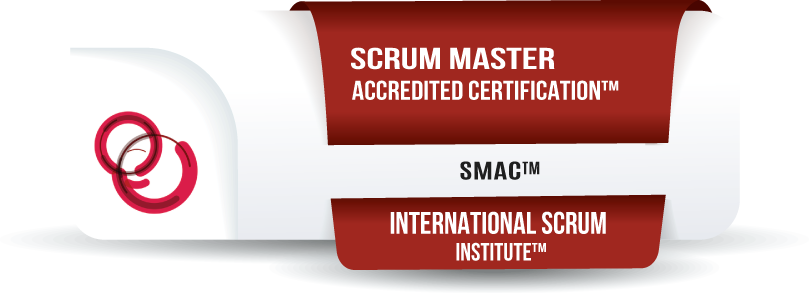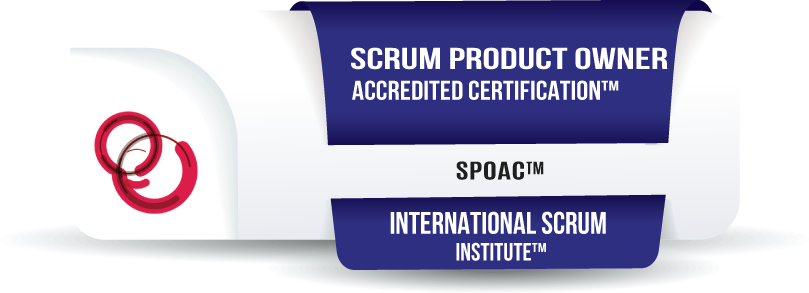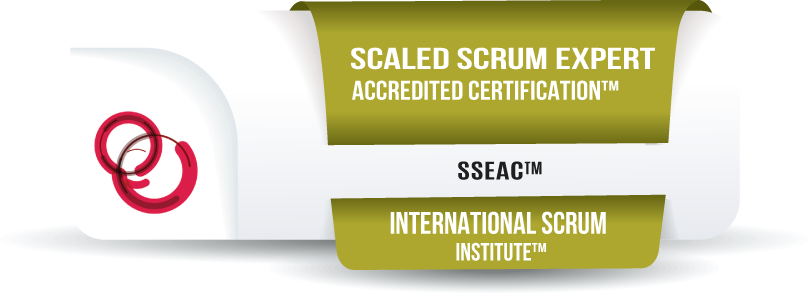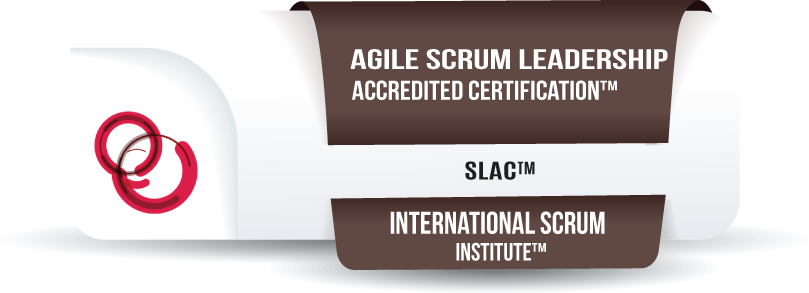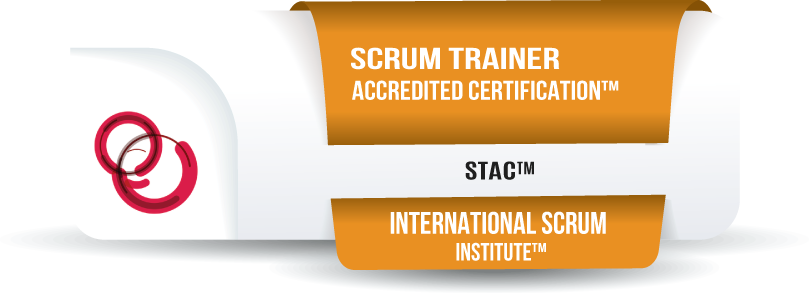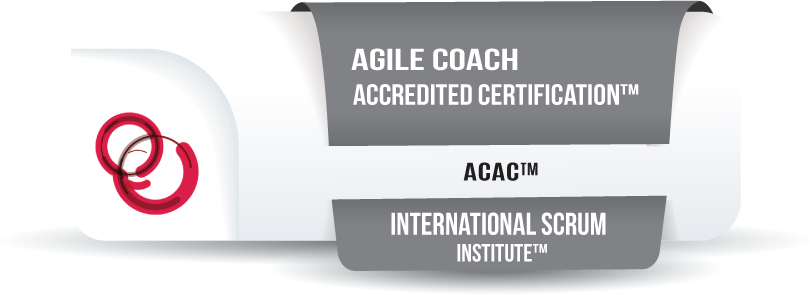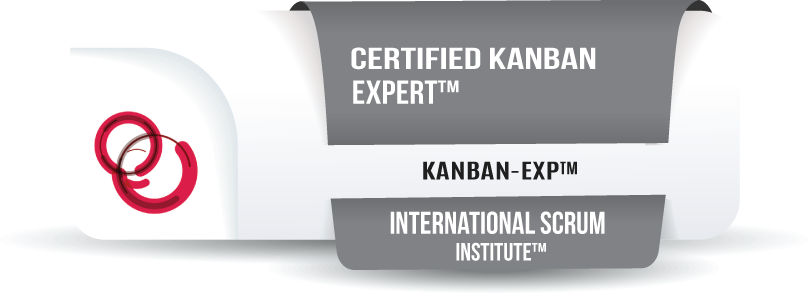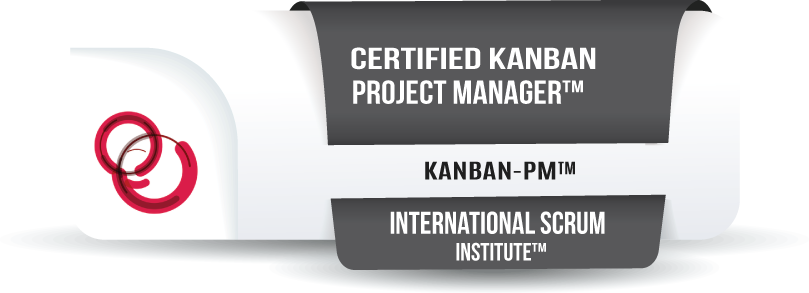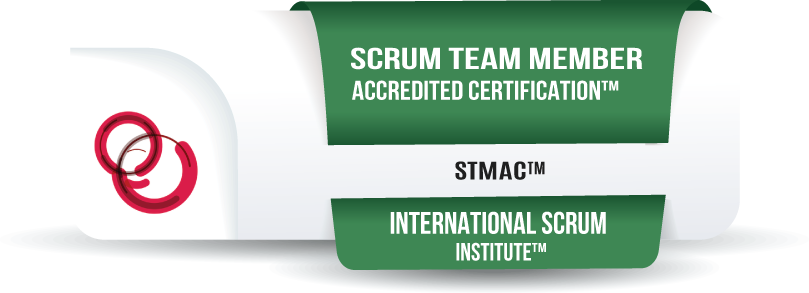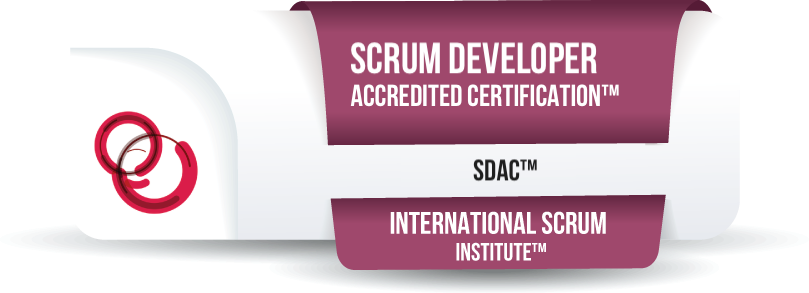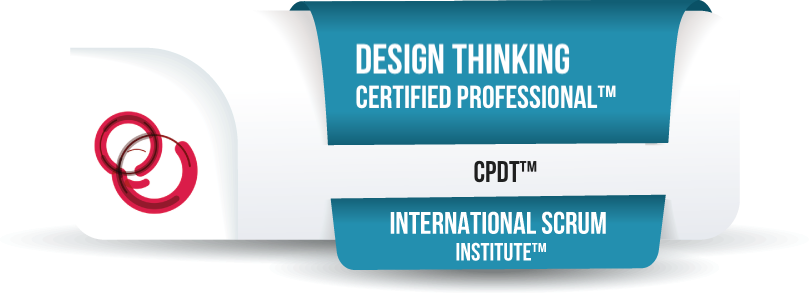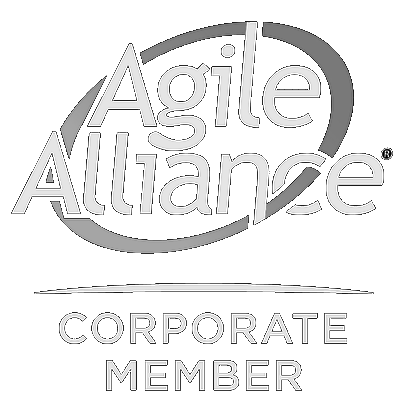Kanban Certification Test Questions and Answers
The Most Realistic 50 Sample Exam Questions
Check out your Example Kanban Certification Test Questions which are very similar to the test and interview questions of Your Certified Kanban Expert (Kanban-EXP) Certification™ and Certified Kanban Project Manager (Kanban-PM) Certification™ Programs.
The primary objective of the International Scrum Institute™ is to provide support to individuals, trainers, and learners at all levels of expertise (ranging from beginners to experienced practitioners) across various industries, both technical and non-technical. Our mission encompasses a wide range of fields, including Kanban, Scrum project management, DevOps, cloud infrastructure, events architecture, people, information, AI, and data science. We strive to empower individuals to enhance their client service capabilities and establish long-lasting business value. By promoting the effectiveness of Kanban, as well as Scrum teamwork and emphasizing the importance of each Kanban and Scrum role, including scrum product owner, and particularly the professional Scrum Master, we ensure seamless collaboration and ways for effective problem-solving within agile project teams. Our goal is to ensure that all employees in your organization are aligned and working towards the same list of objectives.
Even tracking and continuous improvement of this lean product you're using now includes a fair amount of the visual elements that are part of our own Kanban questions and answers and our own Kanban boards.
Once you study questions and answers for your Kanban Certification Program (including those sample questions and Kanban answers provided on the list below), you would love to pursue, you can feel absolutely confident about passing your Kanban Certification exam without any difficulty. Furthermore, our training course, education, study materials, all sample questions, answers and things will ensure your successful and efficient operation as a trained Kanban professional.
Reports show that by practicing a range of Kanban exam questions and answers, a person can be better prepared to:
- Support the vitality and reputation of your business,
- Take the lead in your business field and sector,
- Strengthen your grasp of agile methodologies and excel in clearing the Scrum, Kanban DevOps certification exams,
- Above all, elevate your standing in your industry effortlessly.
Test and Interviews Questions' Editor's Note: When implementing Kanban practice, it is crucial to ask the right interview questions to assess a candidate's understanding and experience with the methodology. Kanban interview questions are designed to delve deeper into a candidate's knowledge of key concepts such as work-in-progress limits, value stream mapping activities, leadership and much more. By asking right Kanban interview questions, organizations can evaluate a candidate's ability to effectively apply these methodologies in real-world scenarios, optimize their workflow, and understand transparency and insight measurement and principle differences between candidates. By asking targeted Kanban interview questions, companies can better understand a candidate's experience with implementing visual management systems and their ability to improve overall company productivity. Kanban, a popular project management methodology, is widely used in various industries to streamline workflow, enhance communication, and ultimately deliver a place of high-quality products and services for reduced costs. In many different technology areas today; business value growth, sales, strategies, suppliers, leadership activities, and project management, Kanban has become an influential framework that businesses are adopting to streamline their processes and improve overall efficiency. It's now your turn to dive deeper into the world of Kanban and explore some common practical certification test and interview questions that arise when implementing this methodology.
By mastering the essential Kanban principles and Kanban topics from our courses based on the Kanban methodology and lean process, you can not only improve your career prospects as a Kanban professional but also provide valuable guidance and support to businesses seeking to adopt agile methodologies in order to stay competitive in today's rapidly evolving market.
Table of Contents
![Example Kanban Certification Test Questions [2026/27] Example Kanban Certification Test Questions [2026/27]](https://scrum-institute.org/images_kanban/Kanban-Workflow-On-A-Kanban-Board.png)
A Clear Kanban Workflow On A Kanban Board
General Kanban Test Questions
Question 1
How does Kanban prevent work over capacity?
- Choice-1: By using Work In Progress (WIP) Limit.
- Choice-2: By setting a robust Kanban workflow.
- Choice-3: By having daily meetings about work in progress.
- Choice-4: By defining explicit policies.
Correct Answer: Choice-1 / By using Work In Progress (WIP) Limit.
Question 2
Which one of the following concepts does the Just-In-Time (JIT) method advocate?
- Choice-1: Upstream processes run simultaneously with downstream processes.
- Choice-2: Processes are triggered by a pull request based on demand.
- Choice-3: Processes are initiated by a push request based on requirements.
- Choice-4: The use of requirement planning to the maximum resource capacity.
Correct Answer: Choice-2 / Processes are triggered by a pull request based on demand.
Question 3
What happens when the Kanban Work In Progress (WIP) limit is not being honored?
- Choice-1: Team throughput increases.
- Choice-2: Processes will suffer from inefficiency.
- Choice-3: Concurrent operations will slow down.
- Choice-4: Feedback loops will be shorter.
Correct Answer: Choice-2 / Processes will suffer from inefficiency.
Question 4
Why must Kanban teams enable quick, constant, and secure feedback loops?
- Choice-1: To fulfill client needs and make them happy.
- Choice-2: To remove flaws and inefficiencies from the Kanban workflow.
- Choice-3: To learn from impediments and avoid running into them in the future.
- Choice-4: All above choices.
Correct Answer: Choice-4 / All above choices.
Question 5
Which one of the following is a reason to use the Kanban “pull” method in production planning?
- Choice-1: It supports the use of long term accurate planning by producing maximum throughput.
- Choice-2: It optimizes the use of resources.
- Choice-3: It makes the requirement of long term accurate planning almost obsolete.
- Choice-4: Both 2 & 3
Correct Answer: Choice-4 / Both 2 & 3
Question 6
When is a signal to replenish stock sent in a Kanban’s Two-Bin System?
- Choice-1: When an item is taken from the first bin.
- Choice-2: When both the first and second bins are empty.
- Choice-3: When the first bin is empty.
- Choice-4: When the first bin is halfway done.
Correct Answer: Choice-3 / When the first bin is empty.
Question 7
Which one of the following is NOT correct about Kanban board columns?
- Choice-1: The more the columns, the better the stages of the process are defined.
- Choice-2: Columns represent the types of works that will go through the process.
- Choice-3: Columns define the Kanban workflow of the operations.
- Choice-4: Columns act as a way of describing the requirements for a final product.
Correct Answer: Choice-4 / Columns act as a way of describing the requirements for a final product.
Question 8
What does a policy in a Kanban board signify?
- Choice-1: The pre-requisites a card should fulfill to be placed in a specific column/status.
- Choice-2: The contents of a Kanban card.
- Choice-3: The required Kanban workflow a board should have.
- Choice-4: All above choices.
Correct Answer: Choice-1 / The pre-requisites a card should fulfill to be placed in a specific column/status.
Question 9
Which one of the following is correct about a Kanban Card?
- Choice-1: Kanban card is a way of signaling which parts are available.
- Choice-2: Kanban card is attached to each item to provide details of the transaction history.
- Choice-3: Kanban card is destroyed once a bin is empty.
- Choice-4: Kanban card is a message that signals the actual status of an item, parts, or requirement in knowledge work such as software engineering.
Correct Answer: Choice-4 / Kanban card is a message that signals the actual status of an item, parts, or requirement in knowledge work such as software engineering.
Question 10
What is the use of introducing Kanban Software Systems (Kanban Board Software)?
- Choice-1: To better see if any Kanban cards are forgotten or lost.
- Choice-2: To help identify typing and manual entry errors.
- Choice-3: To better understand what everyone from the Kanban team is working on.
- Choice-4: All above choices.
Correct Answer: Choice-4 / All above choices.
Send Me My Free Kanban Book >>
Register Kanban Certification >>
Certified Kanban Expert Certification Test Questions
Question 11
You are a Kanban Expert consulting for a software development team. The team has adopted Kanban to manage their work, and they are struggling with bottlenecks and inefficiencies in their process. After analyzing their workflow, you discover that the bottleneck is due to Jane, the only team member who can perform a critical task. The team often finds themselves waiting for Jane's work to progress.
How would you address this issue effectively to improve the team's Kanban system?
- Choice-1: Recommend the team hire and train additional team members to reduce the dependency on Jane.
- Choice-2: Advise the team to eliminate the task that Jane is responsible for to streamline the process.
- Choice-3: Implement Work-in-Progress (WIP) limits on Jane's work to manage the flow and minimize waiting times.
- Choice-4: Encourage the team to ignore the bottleneck and focus on other tasks to keep the process moving.
- Choice-5: Reorganize the team's workflow, so Jane's task is always the first in line, preventing bottlenecks.
Correct Answer: Choice-3: Implement Work-in-Progress (WIP) limits on Jane's work to manage the flow and minimize waiting times.
Question 12
You are a Kanban Expert working with a marketing team that has implemented a Kanban system to manage their campaigns. The team is currently experiencing difficulties in visualizing their work and limiting work in progress effectively.
Which actions would you recommend to help this marketing team improve their Kanban system?
- Choice-1: Introduce a physical Kanban board with columns representing the stages of their campaign workflow to make work more visible.
- Choice-2: Encourage the team to prioritize urgent campaigns over existing ones to ensure timely delivery.
- Choice-3: Implement a strict policy of multitasking to increase overall productivity and responsiveness to clients.
- Choice-4: Suggest the team use a digital project management tool to track their campaigns and automate workflow visualization.
- Choice-5: Advise the team to limit the number of campaigns in progress at any given time and focus on completing them before starting new ones.
Correct Answer: Choice-1: Introduce a physical Kanban board with columns representing the stages of their campaign workflow to make work more visible.
Question 13
You are working with an IT support team that has recently adopted Kanban. The team is facing a recurring issue where high-priority incidents are not receiving immediate attention due to a lack of clear process guidelines.
What should you recommend to address this issue and improve the team's incident management using Kanban?
- Choice-1: Encourage the team to focus on low-priority incidents first to maintain a steady workflow and not disrupt their existing tasks.
- Choice-2: Introduce an expedite lane on the Kanban board for high-priority incidents to ensure they are addressed immediately.
- Choice-3: Suggest the team creates a separate Kanban board exclusively for high-priority incidents, keeping it separate from their regular workflow.
- Choice-4: Advise the team to prioritize low-priority incidents over high-priority ones to maintain overall stability and predictability in their work.
- Choice-5: Recommend the team use a First-Come-First-Served (FCFS) approach, ensuring that incidents are addressed in the order they are reported.
Correct Answer: Choice-2: Introduce an expedite lane on the Kanban board for high-priority incidents to ensure they are addressed immediately.
Question 14
You are consulting with a software development team that uses Kanban to manage their work. They are struggling to maintain a sustainable pace of work and frequently face overburdening. You've noticed that the team members often exceed the Work-in-Progress (WIP) limits they've set for themselves.
What actions would you recommend to help this team regain control of their work and achieve a sustainable flow?
- Choice-1: Suggest the team increase their WIP limits to accommodate their current workload and reduce overburdening.
- Choice-2: Encourage the team to limit their WIP strictly and focus on completing work in progress before starting new tasks, even if it means saying no to additional work.
- Choice-3: Implement a mandatory overtime policy to ensure the team meets their delivery commitments without exceeding WIP limits.
- Choice-4: Advise the team to eliminate WIP limits altogether, allowing them to work without constraints to meet customer demands.
- Choice-5: Recommend the team adopt a hybrid approach, with some WIP limits for critical work and flexibility for less important tasks.
Correct Answer: Choice-2: Encourage the team to limit their WIP strictly and focus on completing work in progress before starting new tasks, even if it means saying no to additional work.
Question 15
You are working with a team responsible for managing a complex project with multiple interconnected tasks. The team has adopted a Kanban approach to visualize and manage their work. They are currently experiencing difficulties in coordinating and ensuring that all tasks are completed in a logical sequence.
What actions would you recommend to help this team streamline their workflow and enhance coordination?
- Choice-1: Advise the team to continue working independently, as Kanban encourages autonomy and minimal coordination between team members.
- Choice-2: Implement a Pull Strategy, where tasks can only move to the next stage when the downstream task is ready to pull it, ensuring logical sequencing.
- Choice-3: Encourage the team to use a Push Strategy, where tasks are pushed to the next stage as soon as they are completed, allowing for quick progress.
- Choice-4: Suggest the team focus on optimizing their individual tasks rather than worrying about coordination, as Kanban relies on individual efficiency.
- Choice-5: Recommend the team adopt a Coordination Board in addition to their Kanban board to track task dependencies and ensure logical sequencing.
Correct Answer: Choice-2: Implement a Pull Strategy, where tasks can only move to the next stage when the downstream task is ready to pull it, ensuring logical sequencing.
Question 16
You are consulting with a manufacturing team that has embraced Kanban to manage their production process. They often face a challenge in determining the optimal batch size for their work items. They want to balance efficiency with minimizing waste.
What recommendations would you make to help this manufacturing team decide on the most suitable batch size for their Kanban system?
- Choice-1: Advise the team to always produce items in the largest batch size possible to maximize efficiency.
- Choice-2: Encourage the team to start with a small batch size and gradually increase it, observing the impact on lead times and efficiency over time.
- Choice-3: Suggest the team conduct a time and motion study to calculate the exact batch size that would minimize waste and maximize efficiency.
- Choice-4: Recommend using a fixed batch size for all work items to simplify the process and reduce variability.
- Choice-5: Advise the team to rely on their intuition and experience to determine the most suitable batch size for each work item based on their judgment of the situation.
Correct Answer: Choice-2: Encourage the team to start with a small batch size and gradually increase it, observing the impact on lead times and efficiency over time.
Question 17
You are working with a customer service team that utilizes Kanban to manage customer requests. The team has concerns about their response times and customer satisfaction. They want to make improvements to their Kanban system to address these issues.
What recommendations would you provide to help the customer service team enhance their Kanban system and improve response times and customer satisfaction?
- Choice-1: Suggest that the team increase their response time targets to ensure they can provide higher-quality responses to customer requests.
- Choice-2: Advise the team to prioritize response times over other metrics and set explicit Service Level Agreements (SLAs) with customers for response times.
- Choice-3: Encourage the team to add more stages to their Kanban board to reflect different levels of priority and complexity in customer requests.
- Choice-4: Recommend the team introduce a Fast Track lane in their Kanban system for urgent customer requests that need immediate attention.
- Choice-5: Advise the team to ignore response times and focus solely on the quality of responses, as Kanban does not explicitly address response times.
Correct Answer: Choice-4: Recommend the team introduce a Fast Track lane in their Kanban system for urgent customer requests that need immediate attention.
Question 18
You are coaching an engineering team that is struggling to balance its work effectively. The team uses Kanban to manage its projects, but they often find themselves pulled in different directions due to urgent requests from various stakeholders.
What actions would you recommend to help this engineering team achieve a balance between managing planned work and addressing urgent requests using Kanban?
- Choice-1: Advise the team to stop accepting urgent requests altogether and focus solely on planned work to maintain stability.
- Choice-2: Encourage the team to implement a separate Kanban board for urgent requests, allowing them to visualize and manage them separately from planned work.
- Choice-3: Suggest the team limit the number of urgent requests they accept simultaneously to ensure they can maintain focus on their planned work.
- Choice-4: Recommend the team dedicate specific times during the day to address urgent requests while allocating the rest of their time to planned work.
- Choice-5: Advise the team to always prioritize urgent requests over planned work to ensure stakeholders' needs are met promptly.
Correct Answer: Choice-3: Suggest the team limit the number of urgent requests they accept simultaneously to ensure they can maintain focus on their planned work.
Question 19
You are working with a cross-functional team that uses Kanban to manage the development of a new software product. The team is facing challenges in maintaining a balanced workflow due to frequent changes in customer requirements and priorities.
What actions would you recommend to help this cross-functional team maintain a balanced workflow and effectively manage changing requirements?
- Choice-1: Advise the team to maintain a rigid Kanban system and reject any changes or new requirements that emerge during the project.
- Choice-2: Encourage the team to implement a regular Change Request Review process where they assess the impact of new requirements on their current work and adjust their Kanban accordingly.
- Choice-3: Suggest the team focus solely on their current Kanban board and avoid any interactions with stakeholders to minimize disruption.
- Choice-4: Recommend that the team adopts a continuous integration and delivery (CI/CD) approach to rapidly incorporate changes without disturbing their current workflow.
- Choice-5: Advise the team to ignore new requirements and focus on their initial project plan as it's not feasible to adapt to changing priorities in Kanban.
Correct Answer: Choice-2: Encourage the team to implement a regular Change Request Review process where they assess the impact of new requirements on their current work and adjust their Kanban accordingly.
Question 20
You are consulting with an operations team that uses Kanban to manage its work processes. The team is concerned about maintaining a consistent and predictable flow of work. They often face variations in the time it takes to complete different types of tasks.
What actions would you recommend to help this operations team achieve a more consistent and predictable flow of work using Kanban?
- Choice-1: Advise the team to eliminate the variety in their tasks by standardizing all work processes to achieve consistent flow.
- Choice-2: Encourage the team to create separate swimlanes on their Kanban board for different types of tasks, allowing them to visualize and manage each category separately.
- Choice-3: Suggest the team implement a Just-in-Time (JIT) approach, where tasks are only pulled into the workflow when the team is ready to work on them.
- Choice-4: Recommend that the team adopt a flexible approach, acknowledging that some tasks will naturally take longer than others and focusing on optimizing overall flow rather than individual tasks.
- Choice-5: Advise the team to allocate more resources to the tasks that take longer to complete to speed up the process and ensure consistent flow.
Correct Answer: Choice-4: Recommend that the team adopt a flexible approach, acknowledging that some tasks will naturally take longer than others and focusing on optimizing overall flow rather than individual tasks.
Question 21
You are a Kanban Expert working with a software development team. The team has implemented a Kanban system to manage their work. Recently, they have been experiencing frequent bottlenecks in the "In Progress" column, leading to delays in delivering user stories.
- Choice-1: You recommend increasing the Work In Progress (WIP) limits in the "In Progress" column to speed up the work process.
- Choice-2: You advise the team to analyze the root causes of the bottlenecks and focus on resolving the underlying issues.
- Choice-3: You suggest splitting user stories into smaller tasks to reduce the time they spend in the "In Progress" column.
- Choice-4: You ask the team to work longer hours to clear the backlog of work in the "In Progress" column.
- Choice-5: You recommend removing the "In Progress" column from the Kanban board to simplify the process.
Correct Answer: Choice-2: You advise the team to analyze the root causes of the bottlenecks and focus on resolving the underlying issues.
Question 22
You are coaching a team that is new to Kanban and is struggling to visualize their work effectively. They are using a physical board but find it challenging to manage their tasks.
- Choice-1: You recommend switching to a digital Kanban tool to simplify work visualization.
- Choice-2: You suggest that the team should attend a Kanban training session to better understand how to use the physical board effectively.
- Choice-3: You propose introducing WIP limits and helping the team establish a clearer process on their physical board.
- Choice-4: You advise the team to abandon Kanban and switch to a different project management methodology.
- Choice-5: You encourage the team to ignore the visualization aspect and focus solely on the work itself.
Correct Answer: Choice-3: You propose introducing WIP limits and helping the team establish a clearer process on their physical board.
Question 23
You are working with a team that has been using Kanban for a while. However, team members often seem overwhelmed and struggle to maintain a healthy work-life balance due to a constant flow of work.
- Choice-1: You recommend that the team implements strict working hours and enforces breaks to ensure a better work-life balance.
- Choice-2: You encourage the team to ignore work-life balance for the sake of delivering more work in a shorter time frame.
- Choice-3: You propose introducing a "Stop-the-Line" policy, allowing team members to halt work when they feel overwhelmed.
- Choice-4: You suggest reducing WIP limits to give team members more time to focus on their work and personal life.
- Choice-5: You advise the team to allocate specific days for work and days for personal life to maintain balance.
Correct Answer: Choice-3: You propose introducing a "Stop-the-Line" policy, allowing team members to halt work when they feel overwhelmed.
Question 24
You are a Kanban Expert working with a marketing team. The team has been using Kanban to manage their campaigns, but they are struggling to meet tight deadlines. The team believes that Kanban is not suitable for their fast-paced work environment.
- Choice-1: You suggest transitioning the marketing team to a Scrum framework, which may be better suited for their fast-paced work environment.
- Choice-2: You encourage the team to establish clear policies and WIP limits to bring more discipline to their workflow in the Kanban system.
- Choice-3: You advise the team to abandon Kanban and manage their work informally without a specific methodology.
- Choice-4: You recommend hiring more team members to increase the capacity to meet tight deadlines within Kanban.
- Choice-5: You propose reducing the scope of marketing campaigns to fit the team's current capacity within Kanban.
Correct Answer: Choice-2: You encourage the team to establish clear policies and WIP limits to bring more discipline to their workflow in the Kanban system.
Question 25
You are consulting with a software development team that has implemented Kanban. However, there is a recurring issue where the team often neglects important system maintenance tasks because they prioritize new feature development.
- Choice-1: You suggest that the team stops all feature development and focuses solely on system maintenance until everything is up to date.
- Choice-2: You advise the team to ignore system maintenance tasks as long as they do not directly impact the current user stories in progress.
- Choice-3: You recommend allocating a fixed percentage of work to system maintenance in each iteration to balance feature development and maintenance.
- Choice-4: You propose hiring a separate team to exclusively handle system maintenance tasks, allowing the development team to focus on new features.
- Choice-5: You encourage the team to create a separate Kanban board dedicated to system maintenance tasks to manage them effectively.
Correct Answer: Choice-3: You recommend allocating a fixed percentage of work to system maintenance in each iteration to balance feature development and maintenance.
Question 26
You are working with a cross-functional team that has embraced Kanban. They have identified that some team members have specialized skills, making them the bottleneck in certain work items.
- Choice-1: You suggest reassigning team members to minimize specialized skills and avoid bottlenecks.
- Choice-2: You advise the team to add more WIP limits to the specialized skills column to control the flow better.
- Choice-3: You recommend that the team focuses on cross-training to reduce dependencies on specialized skills and promote a more balanced workflow.
- Choice-4: You encourage the team to maintain the status quo and work around the bottlenecks as part of the Kanban process.
- Choice-5: You propose changing the team structure to separate work items that require specialized skills from those that don't to optimize workflow.
Correct Answer: Choice-3: You recommend that the team focuses on cross-training to reduce dependencies on specialized skills and promote a more balanced workflow.
Question 27
You are a Kanban Expert working with a customer support team that uses Kanban to manage incoming customer requests. The team has been struggling to meet service level agreements (SLAs) for resolving customer issues.
- Choice-1: You suggest that the team should ignore SLAs and focus on providing quality support without time constraints.
- Choice-2: You advise the team to increase the Work In Progress (WIP) limits to handle more customer requests simultaneously and meet SLAs.
- Choice-3: You propose a review of the SLAs and recommend updating them to align with the team's current capacity realistically.
- Choice-4: You encourage the team to work longer hours to meet the existing SLAs and avoid any backlog of customer requests.
- Choice-5: You recommend hiring additional customer support agents to increase the team's capacity and meet SLAs more effectively.
Correct Answer: Choice-3: You propose a review of the SLAs and recommend updating them to align with the team's current capacity realistically.
Question 28
You are working with an operations team that uses Kanban to manage their work. They have observed that they often receive urgent tasks that disrupt their planned work. The team is struggling to maintain a stable workflow.
- Choice-1: You recommend that the team should ignore urgent tasks and continue with their planned work to maintain a stable workflow.
- Choice-2: You advise the team to create a separate "Urgent" lane on the Kanban board to manage such tasks separately without affecting the regular workflow.
- Choice-3: You propose allocating a specific percentage of capacity to urgent tasks, ensuring a balance between planned and unplanned work.
- Choice-4: You encourage the team to work overtime to accommodate both planned and urgent tasks without affecting the flow.
- Choice-5: You recommend hiring additional team members dedicated to handling urgent tasks, allowing the rest of the team to focus on planned work.
Correct Answer: Choice-3: You propose allocating a specific percentage of capacity to urgent tasks, ensuring a balance between planned and unplanned work.
Question 29
You are coaching a team that is new to Kanban, and they are facing challenges in establishing effective policies and visualizing their workflow. They are unsure about the right approach to setting up their Kanban system.
- Choice-1: You recommend copying the Kanban system of a successful team in a different department to avoid reinventing the wheel.
- Choice-2: You advise the team to hold a workshop to collaboratively define their workflow, WIP limits, and policies that best suit their specific needs.
- Choice-3: You suggest creating a simple Kanban board with a generic workflow and adjusting it over time as the team gains experience.
- Choice-4: You encourage the team to hire a Kanban consultant to design and implement their Kanban system for them.
- Choice-5: You recommend switching to a different project management methodology as Kanban may not be suitable for the team's specific needs.
Correct Answer: Choice-2: You advise the team to hold a workshop to collaboratively define their workflow, WIP limits, and policies that best suit their specific needs.
Question 30
You are working with a software development team that has been using Kanban for some time. Recently, they have been encountering issues with scope creep as new requirements are continuously added to existing user stories.
- Choice-1: You recommend the team to reject any additional requirements once a user story is in progress to maintain scope stability.
- Choice-2: You encourage the team to embrace changes and continuously update the user stories to accommodate new requirements as they arise.
- Choice-3: You suggest implementing a change request process where new requirements go through a review and approval before being added to user stories.
- Choice-4: You propose freezing the user stories and allocating additional capacity to address new requirements separately without affecting ongoing work.
- Choice-5: You recommend transitioning the team to a different project management methodology as Kanban may not be suitable for handling evolving requirements.
Correct Answer: Choice-3: You suggest implementing a change request process where new requirements go through a review and approval before being added to user stories.
Send Me My Free Kanban Book >>
Register Kanban Certification >>
Certified Kanban Project Manager Certification Test Questions
Question 31
You are a Kanban Project Manager leading a software development team. During a Kanban system design session, John, a team member, suggests that limiting work in progress (WIP) is unnecessary and that the team should work on as many tasks as possible simultaneously to increase productivity. Sarah, another team member, disagrees and believes that WIP limits are crucial for maintaining a smooth flow.
What would be the most appropriate response as a Kanban Project Manager to resolve this disagreement?
- Choice-1: Explain the benefits of WIP limits, such as reducing multitasking, improving lead times, and enhancing predictability, and ask the team to give them a try.
- Choice-2: Ignore both perspectives and let the team decide whether to implement WIP limits or not.
- Choice-3: Remove John from the team since he opposes the Kanban principles and is detrimental to the team's success.
- Choice-4: Implement WIP limits without consulting the team to maintain order in the workflow.
- Choice-5: Hold a team-wide vote to decide whether WIP limits should be implemented or not.
Correct Answer: Choice-1: Explain the benefits of WIP limits, such as reducing multitasking, improving lead times, and enhancing predictability, and ask the team to give them a try.
Question 32
Your Kanban project is facing delays in delivering work items, and stakeholders are concerned about the project's progress. As a Kanban Project Manager, you want to address this issue and ensure timely delivery.
What actions should you take to improve the flow of work items and meet stakeholders' expectations?
- Choice-1: Implement WIP limits and make them more stringent to reduce the number of concurrent work items in progress.
- Choice-2: Introduce additional work item types to increase diversity and cater to different stakeholders' needs.
- Choice-3: Engage stakeholders in a collaborative discussion to understand their priorities and adjust work item types and WIP limits accordingly.
- Choice-4: Ignore stakeholder concerns and continue with the current Kanban process, as changes might disrupt the team's flow.
- Choice-5: Reassign team members to different roles to speed up work item delivery and minimize delays.
Correct Answer: Choice-3: Engage stakeholders in a collaborative discussion to understand their priorities and adjust work item types and WIP limits accordingly.
Question 33
In a Kanban project, you observe that team members are regularly exceeding their WIP limits and taking on more work than they can handle. This has resulted in a backlog of delayed work items and decreased flow efficiency.
What would be your most suitable approach as a Kanban Project Manager to address this issue?
- Choice-1: Blame individual team members for exceeding their WIP limits and threaten them with consequences if it continues.
- Choice-2: Remove WIP limits and let team members decide how much work they can handle to avoid bottlenecks.
- Choice-3: Hold a retrospective with the team to identify the reasons for exceeding WIP limits and collaboratively find solutions to maintain flow efficiency.
- Choice-4: Assign a higher WIP limit to the entire team to accommodate their increased workload and maintain productivity.
- Choice-5: Replace team members who cannot adhere to WIP limits with new members who are more disciplined.
Correct Answer: Choice-3: Hold a retrospective with the team to identify the reasons for exceeding WIP limits and collaboratively find solutions to maintain flow efficiency.
Question 34
Your Kanban team is struggling to prioritize work items effectively, resulting in a lack of focus and frequent shifts in task assignments. This is causing confusion and delays in work completion.
As a Kanban Project Manager, how can you help the team improve their work item prioritization process?
- Choice-1: Implement strict priority rules and prohibit any changes to the work item sequence during a Kanban cycle and satisfy the cycle time.
- Choice-2: Encourage team members to randomly choose work items to increase diversity in their tasks and boost creativity.
- Choice-3: Hold a workshop with the team to collaboratively define and refine work item prioritization criteria, ensuring clear expectations and alignment with goals.
- Choice-4: Assign a dedicated team member to make all prioritization decisions to reduce conflicts and maintain a consistent order of work items.
- Choice-5: Ignore the issue and let team members continue to prioritize work items independently as they see fit.
Correct Answer: Choice-3: Hold a workshop with the team to collaboratively define and refine work item prioritization criteria, ensuring clear expectations and alignment with goals.
Question 35
You are managing a Kanban project for a marketing team, and you have noticed that the team frequently faces last-minute requests from various stakeholders, disrupting their workflow. This has caused frustration among team members and negatively impacted the team's performance.
What steps can you, as a Kanban Project Manager, take to reduce these last-minute requests and maintain a more stable workflow?
- Choice-1: Introduce a strict policy that forbids any changes or new requests once the team has started working on their current tasks.
- Choice-2: Implement WIP limits for stakeholder requests and encourage them to prioritize their needs, helping reduce the number of last-minute requests.
- Choice-3: Allow last-minute requests to continue as they are an essential part of the business, and the team should adapt to the dynamic environment.
- Choice-4: Hold regular meetings with stakeholders to educate them about the team's process and the impact of last-minute requests on the workflow.
- Choice-5: Hire additional team members to accommodate last-minute requests and ensure the team can handle them without disruption.
Correct Answer: Choice-4: Hold regular meetings with stakeholders to educate them about the team's process and the impact of last-minute requests on the workflow.
Question 36
You are the Kanban Project Manager of a software development team. The team is currently working on a project with multiple stakeholders who have conflicting priorities. This has led to frequent changes in work item priorities and frequent disruptions in the team's workflow.
As a Kanban Project Manager, how can you address the issue of conflicting stakeholder priorities and create a more stable working environment for the team?
- Choice-1: Allow stakeholders to set priorities independently, as they are the ones requesting the work, even if it results in frequent changes and disruptions.
- Choice-2: Implement WIP limits for each stakeholder to ensure they can only have a certain number of items in progress, helping to manage conflicting priorities.
- Choice-3: Hold a collaborative workshop with all stakeholders to align on priorities, discuss the impact of frequent changes, and agree on a prioritization strategy.
- Choice-4: Assign a dedicated team member to manage stakeholder priorities and decide which items should be worked on to minimize conflicts.
- Choice-5: Ignore the conflicting priorities and focus on delivering work items as they come in, allowing the team to adapt to changes as needed.
Correct Answer: Choice-3: Hold a collaborative workshop with all stakeholders to align on priorities, discuss the impact of frequent changes, and agree on a prioritization strategy.
Question 37
Your Kanban project has been running smoothly, but you notice that the team's flow efficiency has started to decrease. Upon investigation, you find that team members are frequently interrupted by ad-hoc meetings and support requests, making it challenging to focus on their work.
What actions should you, as a Kanban Project Manager, take to help the team regain their flow efficiency and reduce interruptions?
- Choice-1: Require team members to decline all meetings and requests that are not related to their ongoing work to maintain focus.
- Choice-2: Implement a strict policy that restricts all meetings to specific time slots during the day, allowing uninterrupted work in between.
- Choice-3: Hold a meeting with stakeholders to discuss the impact of interruptions on the team's productivity and collaborate on setting boundaries for meetings and support requests.
- Choice-4: Assign a team member as a gatekeeper to filter and prioritize interruptions, ensuring that only critical requests reach the team.
- Choice-5: Ignore the interruptions and let the team manage them on their own, as it is their responsibility to handle all incoming work and requests.
Correct Answer: Choice-3: Hold a meeting with stakeholders to discuss the impact of interruptions on the team's productivity and collaborate on setting boundaries for meetings and support requests.
Question 38
In your Kanban project, the team has been experiencing bottlenecks in certain stages of the workflow, causing delays and frustration among team members. Despite attempts to address the issue, the bottlenecks persist.
As a Kanban Project Manager, what steps can you take to identify and resolve the root cause of these recurring bottlenecks?
- Choice-1: Assign more team members to the stages with bottlenecks to increase capacity and reduce delays.
- Choice-2: Remove WIP limits in the bottleneck stages to allow work to flow freely and eliminate delays.
- Choice-3: Conduct a root cause analysis with the team to identify the specific reasons for the bottlenecks and collaboratively find solutions to address them.
- Choice-4: Ignore the bottlenecks and focus on the other stages of the workflow where work is progressing smoothly to maintain overall productivity.
- Choice-5: Implement a policy that allows work to bypass the bottleneck stages and continue to other stages, even if it means rework or inefficiencies.
Correct Answer: Choice-3: Conduct a root cause analysis with the team to identify the specific reasons for the bottlenecks and collaboratively find solutions to address them.
Question 39
Your Kanban team has encountered a situation where two team members, Lisa and James, consistently take on more work items than others, leading to an imbalance in work distribution. This has caused resentment among team members, as some feel overwhelmed while others have lighter workloads.
As a Kanban Project Manager, how can you address this issue and ensure a fair distribution of work among team members?
- Choice-1: Assign Lisa and James to work on all new items to ensure a fair distribution of tasks among team members.
- Choice-2: Implement a policy that restricts Lisa and James from taking on more than a certain number of work items to create a balanced workload for all team members.
- Choice-3: Hold a team meeting to discuss the issue, encourage team members to openly communicate their concerns, and collaboratively agree on a fair work distribution strategy.
- Choice-4: Ignore the issue, as team members should manage their workloads independently and it is not the responsibility of the Kanban Project Manager to intervene.
- Choice-5: Replace Lisa and James with new team members who can better adapt to a balanced workload.
Correct Answer: Choice-3: Hold a team meeting to discuss the issue, encourage team members to openly communicate their concerns, and collaboratively agree on a fair work distribution strategy.
Question 40
Your Kanban project team is experiencing a lack of motivation and enthusiasm among team members. They have been working on the same type of tasks for an extended period, leading to a sense of monotony and boredom.
As a Kanban Project Manager, how can you reinvigorate the team and boost their motivation?
- Choice-1: Assign team members to different roles to introduce variety in their work and break the monotony.
- Choice-2: Implement a strict policy that requires team members to complete their assigned tasks without complaining about monotony.
- Choice-3: Hold a team brainstorming session to identify opportunities for process improvements, skill development, or new projects that can bring excitement to the team's work.
- Choice-4: Assign additional tasks to team members to keep them busy and prevent boredom from setting in.
- Choice-5: Ignore the team's feelings of monotony, as it is a common experience in long-term projects, and it is the team's responsibility to cope with it.
Correct Answer: Choice-3: Hold a team brainstorming session to identify opportunities for process improvements, skill development, or new projects that can bring excitement to the team's work.
Question 41
In your Kanban project, you have noticed that the team is frequently delayed by a backlog of work items that are waiting for approval from external stakeholders. These delays are impacting the team's flow efficiency and overall project performance.
What actions should you, as a Kanban Project Manager, take to address this issue and minimize the impact of external stakeholder approvals on the project?
- Choice-1: Assign team members to handle stakeholder approvals directly, bypassing the external stakeholders to expedite the process.
- Choice-2: Implement a policy that allows work items to continue to the next stage without external stakeholder approval, even if it means rework or adjustments later on.
- Choice-3: Hold a meeting with external stakeholders to discuss the impact of their delayed approvals on the project's flow and collaboratively find solutions to expedite the approval process.
- Choice-4: Ignore the delays and allow the team to adapt to the unpredictable nature of external stakeholder approvals, as it is beyond the team's control.
- Choice-5: Reassign work items that require external stakeholder approval to a different project to prevent disruptions to the team's flow.
Correct Answer: Choice-3: Hold a meeting with external stakeholders to discuss the impact of their delayed approvals on the project's flow and collaboratively find solutions to expedite the approval process.
Question 42
In your Kanban project, team members are experiencing high levels of stress and burnout due to a constant demand for urgent work items. This has resulted in a decrease in the team's overall well-being and work quality.
As a Kanban Project Manager, how can you address the issue of stress and burnout and promote a healthier work environment for the team?
- Choice-1: Ignore the issue, as high stress levels are common in the industry, and team members should adapt to the demands of the job.
- Choice-2: Implement a policy that prohibits team members from taking sick leave or time off to ensure continuous work on urgent items.
- Choice-3: Hold individual meetings with team members to discuss their stress levels, identify sources of stress, and collaboratively find solutions to reduce workload and stress.
- Choice-4: Assign additional work to team members to distribute the workload and alleviate stress by sharing responsibilities.
- Choice-5: Implement a policy that limits the number of urgent work items in progress to ensure a healthier work-life balance for team members.
Correct Answer: Choice-3: Hold individual meetings with team members to discuss their stress levels, identify sources of stress, and collaboratively find solutions to reduce workload and stress.
Question 43
Your Kanban project team has been experiencing difficulties in visualizing the workflow and identifying bottlenecks. Team members struggle to understand where work items are in the process and the reasons for delays.
As a Kanban Project Manager, how can you help the team improve their workflow visualization and identify bottlenecks more effectively?
- Choice-1: Remove the Kanban board and visualization tools to simplify the process and eliminate confusion among team members.
- Choice-2: Implement more complex visualization tools and metrics to provide detailed insights into the workflow, allowing team members to identify bottlenecks more accurately.
- Choice-3: Conduct a workshop with the team to educate them on Kanban principles, the use of visualization tools, and how to identify and address bottlenecks effectively.
- Choice-4: Ignore the team's struggles with workflow visualization and let them adapt to the existing process, as it is their responsibility to make it work.
- Choice-5: Assign a dedicated team member to monitor the Kanban board and provide continuous guidance to team members on how to identify bottlenecks.
Correct Answer: Choice-3: Conduct a workshop with the team to educate them on Kanban principles, the use of visualization tools, and how to identify and address bottlenecks effectively.
Question 44
Your Kanban project team is experiencing challenges in meeting the quality standards for their work. Defects and errors are frequently found in the completed work items, leading to rework and delays.
As a Kanban Project Manager, how can you help the team address the issue of declining work quality and maintain high standards?
- Choice-1: Implement a policy that requires team members to complete work items within a shorter timeframe to reduce delays and minimize the chances of defects.
- Choice-2: Assign an external quality assurance team to review and approve all work items before they are considered complete to ensure high quality.
- Choice-3: Hold a retrospective with the team to identify the root causes of quality issues and collaboratively find solutions to improve the quality of work.
- Choice-4: Increase the work in progress (WIP) limits to allow team members to spend more time on each work item and ensure higher quality.
- Choice-5: Ignore the quality issues, as they are a common occurrence in the industry, and team members should adapt to the demands of the job.
Correct Answer: Choice-3: Hold a retrospective with the team to identify the root causes of quality issues and collaboratively find solutions to improve the quality of work.
Question 45
Your Kanban project team is frequently missing deadlines, and stakeholders are becoming increasingly dissatisfied with the project's progress. The team is struggling to meet the expectations set by stakeholders, resulting in a negative impact on the project's reputation.
What actions should you, as a Kanban Project Manager, take to address the issue of missed deadlines and restore stakeholder confidence in the project?
- Choice-1: Implement a policy that enforces strict deadlines and consequences for team members who fail to meet them to ensure on-time delivery.
- Choice-2: Ignore the issue, as missed deadlines are common in the industry, and stakeholders should understand the challenges of the project.
- Choice-3: Hold a meeting with stakeholders to discuss the project's challenges, openly communicate about missed deadlines, and collaboratively find solutions to improve performance.
- Choice-4: Assign additional team members to the project to increase capacity and ensure timely delivery.
- Choice-5: Implement a policy that restricts stakeholder requests and changes to reduce scope creep and allow the team to focus on meeting deadlines.
Correct Answer: Choice-3: Hold a meeting with stakeholders to discuss the project's challenges, openly communicate about missed deadlines, and collaboratively find solutions to improve performance.
Question 46
Your Kanban project team is experiencing a lack of alignment between team members' skillsets and the work items they are assigned. Some team members are frequently working on tasks that do not match their expertise, leading to inefficiency and errors in the work.
As a Kanban Project Manager, how can you address this issue and ensure that team members are assigned work that aligns with their skills and expertise?
- Choice-1: Implement a policy that randomly assigns work items to team members to increase diversity in their tasks and encourage skill development.
- Choice-2: Hold a meeting with team members to discuss their individual skills and expertise, and collaboratively create a skill matrix to guide work assignments.
- Choice-3: Ignore the issue, as team members should be adaptable and able to handle tasks outside their expertise to maintain flexibility.
- Choice-4: Assign a dedicated team member to manage work assignments and ensure that each team member receives tasks that align with their skills.
- Choice-5: Implement a policy that allows team members to choose their own work items to ensure they work on tasks that match their expertise.
Correct Answer: Choice-2: Hold a meeting with team members to discuss their individual skills and expertise, and collaboratively create a skill matrix to guide work assignments.
Question 47
In your Kanban project, team members have been struggling to communicate effectively with external stakeholders. There is often confusion about stakeholder requirements, resulting in delays and revisions to work items.
As a Kanban Project Manager, how can you improve communication between the team and external stakeholders to ensure a better understanding of requirements and smoother project execution?
- Choice-1: Implement a policy that restricts direct communication between team members and external stakeholders, ensuring all communication goes through a centralized channel.
- Choice-2: Assign a dedicated team member as a liaison between the team and external stakeholders to facilitate clear communication and requirement understanding.
- Choice-3: Hold a series of meetings with external stakeholders to educate them about the team's process, requirements gathering, and the importance of clear and concise communication.
- Choice-4: Ignore the communication issues, as it is the responsibility of team members to adapt to the needs of external stakeholders and ensure clarity.
- Choice-5: Implement a policy that requires team members to take detailed notes during discussions with external stakeholders to minimize miscommunication.
Correct Answer: Choice-2: Assign a dedicated team member as a liaison between the team and external stakeholders to facilitate clear communication and requirement understanding.
Question 48
Your Kanban project team has been experiencing a lack of innovation and creativity in their work. Team members tend to follow a routine and are hesitant to explore new approaches or ideas.
As a Kanban Project Manager, how can you encourage innovation and creativity within the team to enhance their problem-solving capabilities and overall performance?
- Choice-1: Implement a policy that restricts team members from deviating from their routine tasks to ensure consistency and predictability.
- Choice-2: Assign a dedicated team member as an innovation leader to introduce new ideas and approaches to the team.
- Choice-3: Hold regular brainstorming sessions with the team to encourage the generation of innovative ideas and explore new approaches to work.
- Choice-4: Ignore the lack of innovation, as it is not a critical factor in the project's success, and the team's primary focus should be on task completion.
- Choice-5: Implement a policy that requires team members to adhere strictly to existing processes and avoid introducing new ideas or approaches.
Correct Answer: Choice-3: Hold regular brainstorming sessions with the team to encourage the generation of innovative ideas and explore new approaches to work.
Question 49
Your Kanban project team has been facing challenges in managing dependencies with other teams. This often leads to delays and disruptions in the workflow, affecting project timelines and stakeholder satisfaction.
As a Kanban Project Manager, how can you address the issue of inter-team dependencies and improve collaboration with other teams to minimize disruptions?
- Choice-1: Implement a policy that prohibits any interaction or dependency between your team and other teams to maintain autonomy and avoid disruptions.
- Choice-2: Assign a dedicated team member as an inter-team coordinator to facilitate communication and collaboration with other teams, managing dependencies effectively.
- Choice-3: Hold joint meetings with other teams to identify and document dependencies, agree on clear communication channels, and collaboratively find solutions to manage dependencies.
- Choice-4: Ignore the inter-team dependency issues, as they are common in the industry, and it is the team's responsibility to adapt to them.
- Choice-5: Implement a policy that allows your team to delay their work until other teams catch up, ensuring a smoother flow of work and reduced disruptions.
Correct Answer: Choice-3: Hold joint meetings with other teams to identify and document dependencies, agree on clear communication channels, and collaboratively find solutions to manage dependencies.
Question 50
Your Kanban project team has encountered resistance from team members who are hesitant to embrace the principles and practices of Kanban. They are comfortable with their existing work methods and are resistant to change.
As a Kanban Project Manager, how can you overcome this resistance and encourage team members to adopt Kanban practices effectively?
- Choice-1: Implement a policy that enforces strict compliance with Kanban practices and consequences for non-compliance to force team members to change their approach.
- Choice-2: Ignore the resistance and let team members continue with their existing work methods, as forcing change may lead to decreased morale.
- Choice-3: Hold team workshops and training sessions to educate team members about the benefits of Kanban, address their concerns, and encourage a gradual transition to Kanban practices.
- Choice-4: Replace team members who resist the adoption of Kanban practices with individuals who are more open to change and new approaches.
- Choice-5: Implement a policy that allows team members to choose whether they want to follow Kanban practices or their existing methods, allowing flexibility within the team.
Correct Answer: Choice-3: Hold team workshops and training sessions to educate team members about the benefits of Kanban, address their concerns, and encourage a gradual transition to Kanban practices.
Send Me My Free Kanban Book >>
Register Kanban Certification >>
 SCRUM INSTITUTE™
SCRUM INSTITUTE™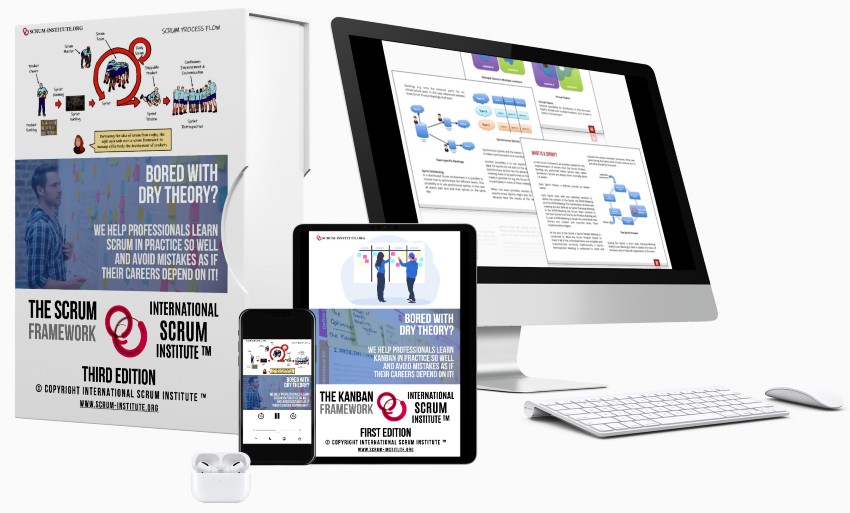

![Example Kanban Certification Test Questions [2026/27] Example Kanban Certification Test Questions [2026/27]](https://scrum-institute.org/images_kanban/Kanban-Workflow-On-A-Kanban-Board.png)


